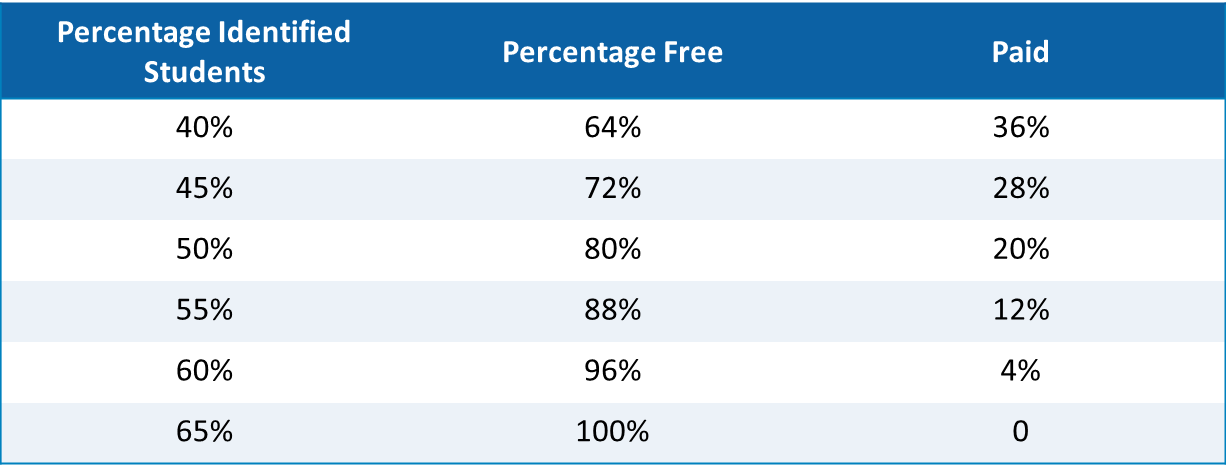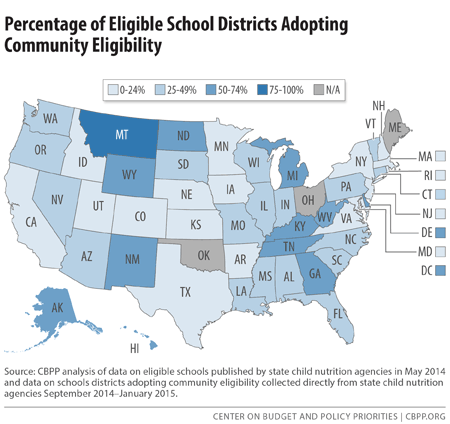An innovative approach to offering universal free school breakfast and lunch
What is it?
The Community Eligibility Provision allows schools and local educational agencies (LEAs) in high-poverty areas to offer free breakfast and lunch to all students without having to go through the standard household application process to determine meal program eligibility. Any school district can use this option if at least one of its schools has 40 percent or more “Identified Students”, meaning, students who are certified for free meals using other forms of direct certification data such as qualifying for Supplemental Nutrition Assistance Progarm (SNAP), Medicaid, Head Start, etc. By removing the burden of having to collect household applications to determine eligibility for the few students that do not qualify for free or reduced-price meals, CEP significantly lessens the administrative work of having to collect and verify school meal applications and allows schools to focus on feeding children.
Introduced by the The Healthy, Hunger-Free Kids Act of 2010, this option is now available to all schools, nationwide – the deadline to opt in for the 2015-2016 school year is August 31, 2015.
What are the benefits?
- Reduced administrative burden – removes paperwork for both parents and school staff, lowering administrative costs, eliminating the need to track unpaid meal charges and allowing staff to focus on improving education and meal service operations.
- Increases participation and factilitates implementation of alternative breakfast models – maximizes access to free nutritious meals to students, reducing stigma and making it easier for schools to implement Breakfast in the Classroom and Grab N Go.
- Improves efficiency and financial viability of school nutrition programs – CEP schools traditionally show significant increases in breakfast and lunch participation, resulting in higher revenue through reimbursements, which districts can use to improve meal program quality.
How it works
The percentage of Identified Students multiplied by 1.6 = the percentage of meals reimbursed at the “free” rate. The rest of the meals are reimbursed at the paid rate. Therefore, the higher the poverty level (Identified Student Percentage), the higher the reimbursement rate.

Schools can determine their eligibility status by visiting the Center on Budget and Policy Priority’s CEP eligibility database and can also use tools like the No Kid Hungry School Calculator to help determine the financial viability of becoming CEP.
Illinois was one of the first states to pilot CEP in the 2011-2012 school year and since then, has grown from less than 250 to over 1,000 schools participating. According to the Food and Research Action Center, breakfast and lunch participation in the first three pilot states, Illinois, Michigan and Kentucky, increased by 25% (29,000 meals) and 13% (23,000 meals) respectively, in CEP schools within the first two years. Such increases in participation underscore the impact of community eligibility and its ability to improve low-income children’s access to healthy meals at school, particularly through the School Breakfast Program, which has been underutilized. Administrators, child nutrition staff, and parents in participating schools, who experience the benefits of community eligibility first hand, have enthusiastically embraced the option¹.
However, compared to the rest of the nation only 55% of Illinois’ eligible school districts and 29% of eligible schools participate¹. This means, we can do better.
What can you do?
- Apply to become CEP for the 2015 – 2016 school year by August 31, 2015 with the Illinois State Board of Education.
- Utilize the tools, resources and information fact sheets on the Share Our Strength Center for Best Practices Community Eligibility Provision webpage.
- Take action and connect with a Rise & Shine breakfast coordinator, who can help:
- Determine the best breakfast plan for your school or district
- Provide technical assistance for implementing CEP and alternative breakfast models
- Assist with applying for Rise & Shine Illinois breakfast grants



